5 ways to fight election disinformation on Bluesky and the Fediverse (REVISED DRAFT)

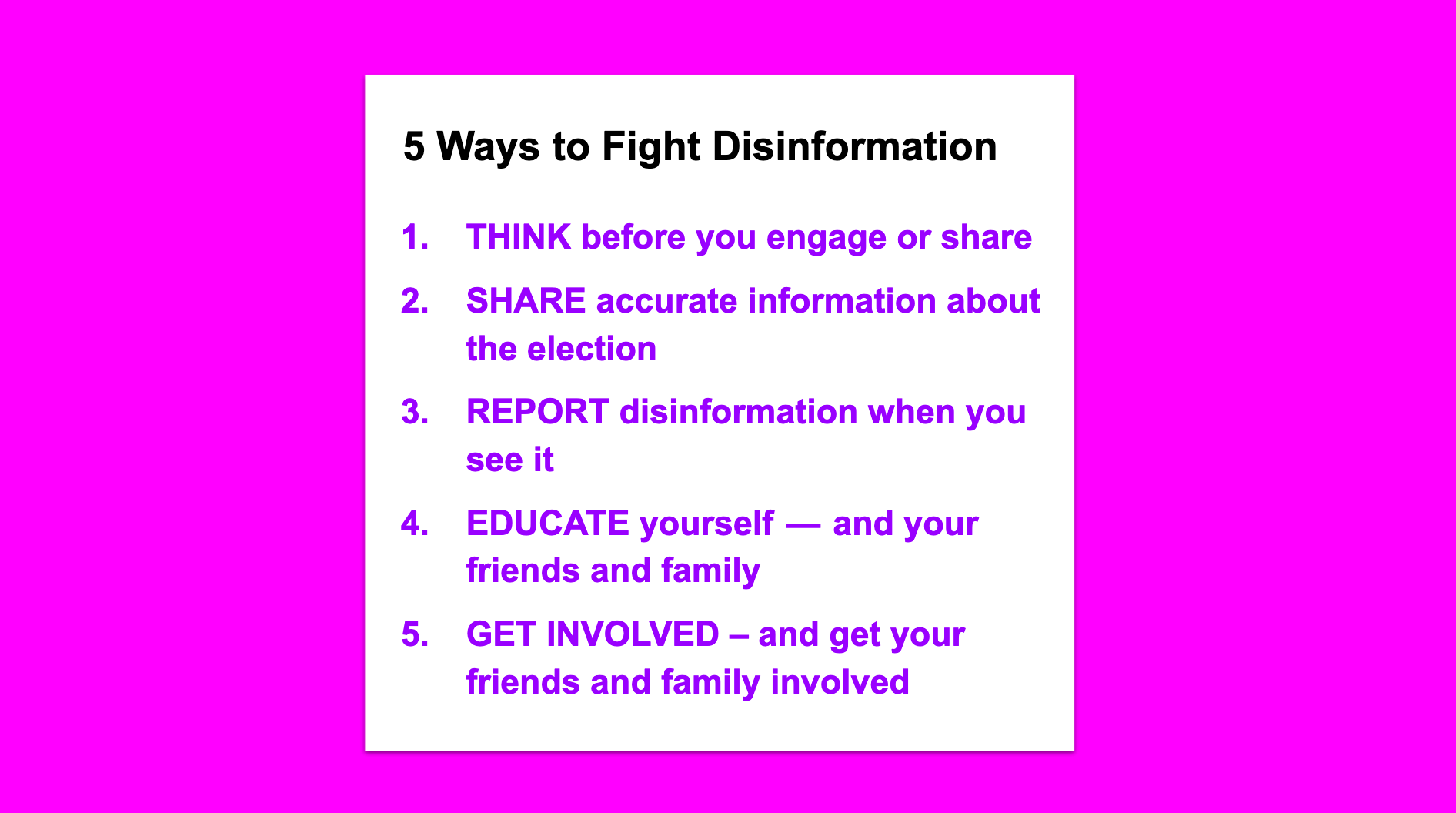
DRAFT! WORK IN PROGRESS!
FEEDBACK WELCOME!
- THINK before you engage or share
- SHARE accurate information about the election
- REPORT disinformation when you see it
- EDUCATE yourself — and your friends and family
- GET INVOLVED – and get your friends and family involved
White supremacists, fascists and their allies are already spewing disinformation to try to steal the US Presidential election. Xitter's white supremacist, pro-fascist dipshit CEO is one 0f them. Meta's fascist-friendly CEO isn't doing anything to stop them – and is suspending the accounts of people who push back. A civil rights coalition is calling on Musk and Zuckerberg to take action against election disinformation, and maybe they'll make some token efforts, but I for one am not holding my breath.
Bluesky and the Fediverse are a lot smaller than Xitter, Threads, Instagram, and Facebook, but the good news is that they're not run by companies that make big bucks from disinfo, white supremacists, and fascists. So as the big networks get overwhelmed by disinfo, we've got a fighting chance to use these smaller decentralized networks as clearer channels to get out accurate information.
We've already seen digital voter suppression (such as false information about polling place locations and hours), and fake reports of "flipped votes" and "non-citizen voting." And it's not always easy to tell what is and isn't real: last week Russian actors in a fake video falsely claimed ballots were being destroyed, this morning, there was a true report of arson at a ballot drop box in Washington state. Between now and November 5 , expect lots of more all of the above – as well as a mix of real and fake reports of voter intimidation.
Once the polls close, it's likely to get even messier. The fascist candidate expected to declare victory on election night no matter what the early results say, and there's likely to be all kinds of chaos on the way to getting the final results. In 2020, election denialism led to a coup attempt. This year ... who knows.
Grassroots election protection activism made the difference in 2020, just as it had in 2008. It's time to do it again. Fighting disinfo is one good way to help – on the Fediverse, and on other social networks.
Here are five easy and important things to do over the next few weeks.
- THINK before you engage or share
- SHARE accurate information about the election
- REPORT disinformation when you see it – see the Appendix for detailed instructions for Bluesky and Mastodon
- EDUCATE yourself — and your friends and family
- GET INVOLVED – and get your friends and family involved
This information was originally based on work done in 2020 with Shireen Mitchell, Stop Online Violence Against Women, Indivisible Plus Washington, Indivisible Whidbey, Washington Indivisible Network, and Indivisible's Truth Brigade. How To Respond to Disinformation and Digital Voter Suppression and Deep Dive goes into more detail (although hasn't been updated for 2024, so some of it's a bit out of date). Thanks to all involved!
1. THINK before you engage or share
Shireen Mitchell’s All of us have been targeted by disinformation
As Shireen says, if you have an immediate reaction to share a link without verifying or fact-checking, you need to pause and look at things differently. One of the goals of disinformation is to get you to react emotionally. Even if it’s something you agree with, it’s important to think before you engage.
- Is the information you’re about to share accurate and from a reliable source? If not, be very careful not to give it more visibility when you’re trying to debunk it.
- Even if the information you’re about to share is accurate, look at the headline and any images that you’re sharing to make sure they’ve got the right framing.
- Avoid headlines, images, and videos that include disinfo. Instead, look for headlines and articles that focus on the accurate information, or report that there’s disinfo but don’t repeat it.
- If you can’t find a headline and article that work well, consider just quoting a few lines from an article (or taking a screenshot) rather than linking.
- Only share screenshots of disinfo if you are clearly visually labeling them as disinfo.
That last bullet is something I really wish more people understood. Back in 2020, when I was working with progressives on Twitter and Facebook, I was constantly exasperated with how often people would amplify disinfo to dunk on it. Now, I'm just as exasperated as how often it happens on Bluesky and the Fediverse. Please don't help white supremacists and fascists by amplifying their propaganda!!!!
Shireen’s Deep Dive on Fighting Back Against Disinfo goes into a lot more detail on this. ReFrame also has some great infographics on how to not amplify disinfo, and Union of Concerned Scientists covers this and a lot of other valuable topics in Countering Disinformation in Your Community.
How to tell whether or not information is accurate? Mike Caulfield’s SIFT (The Four Moves) is a good short introduction to the SIFT method: stop; investigate the source; find better coverage; and trace claims, quotes, and media to the original context. The five-part Check Please! Starter Course goes into much more detail. IFTAS Library’s Misinformation page has links to additional resources for investigating potential disinformation.
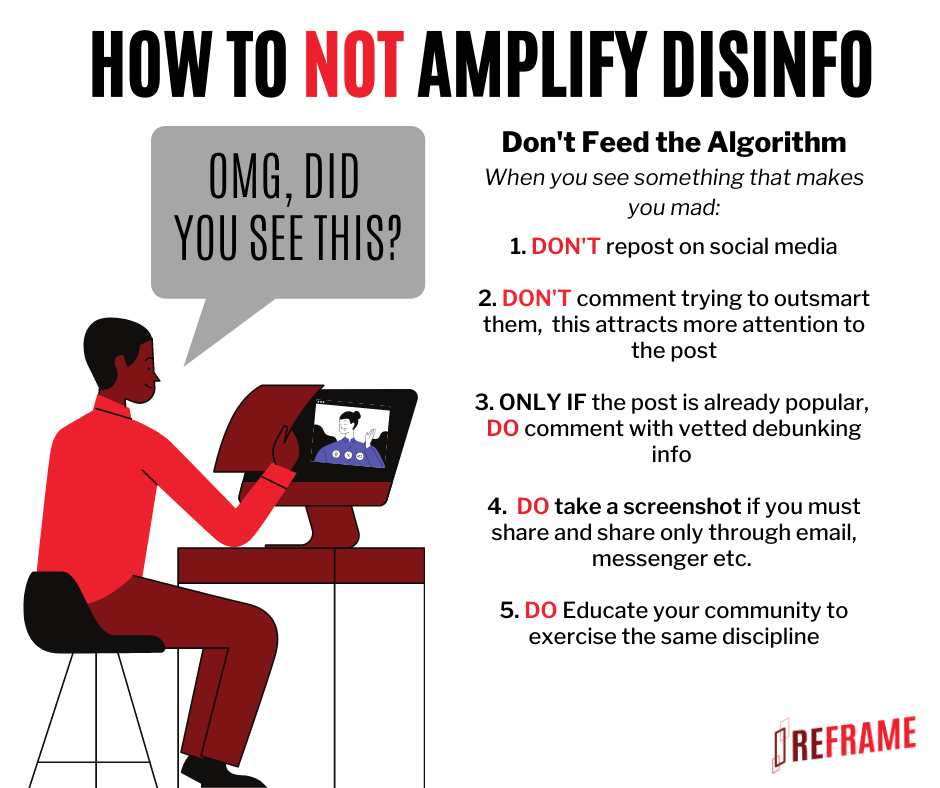
Image description: somebody typing the words "OMG DID YOU SEE THIS". Text: How to not amplify disinfo. Don't feed the algorithm. When you see something that makes you mad: 1. DON’T repost on social media 2. DON’T comment trying to outsmart them, this attracts more attention to the post 3. ONLY IF the post is already popular, DO comment with vetted debugging info. 4. DO take a screenshot if you must share, and share only through email, messenger, etc. 5. DO educate your community to exercise the same discipline. Reframe.
On Bluesky and the Fediverse, the algorithm is people boosting and reskeeting posts. So (just like on Facebook and Twitter with their different approach to algorithms) it's vital to think before you post. Whenever you get share a link (even if you’re saying “OMG look at this fake information!”) or involved in a discussion in the comments debunking or debating a post that’s disinformation, you’re calling more attention to it.
When you do decide to engage with disinformation, here’s the approach that ReFrame and other disinfo experts suggest this four-step process.
- Lead with shared values to connect with your audience.
- Discredit the falsehood by naming the motivations driving the
disinformation. - State the falsehood you intend to inoculate against.
- Deliver factual information to combat the falsehood.
Reframe's Signals in the Noise: Election Edition | 10.22.2024 is a good summary of the current hot-button disinformation tropes. Just as importantly, it's got counter-narratives. For example, here's their counter to false narratives circulating about Democrats and Black voters.
"Polling data only gives us a small slice of the story, and the numbers don’t align with what we know about Black men, who vote second only to Black women. Black men are voting aligned with their interests, their communities and their loved ones. Elevate stories and messages that accentuate people power and how Black men have historically shown up electorally."
2. SHARE accurate information about the election
What is your plan to promote accurate, aspirational and actionable information about the solutions needed to protect your/our freedoms regarding the 2022 midterm election?
– – Shireen Mitchell in Disinformation: A Racist Tactic, from Slave Revolts to Elections
The last few days of voting are always somewhat chaotic: with ballot box and polling place closures, long lines and broken machines, and reports of voter intimidation. One common (and illegal) digital voter suppression tactic is to share wrong addresses or inaccurate hours for polling places via texts and social media. Last minute announcements of poll closures add to the confusion ... sometimes they're real, sometimes they're not.
One good way to counter disinformation about the election process is to share accurate information about the election. Take the time to verify that the information you’re sharing is accurate before you share updates!
Voting rights organizations, official state and county election sites, and reputable local media are usually the most reliable sources. I Will Vote makes it easy to find your voting or drop-off information, for example, and Common Cause lets you find your polling place or find your local election office. Share these links widely!
X (despite all it's problems) is still a good soure for this information. Llists like Election Protection coalition's national and state partners are good starting points. So is The Leadership Conference's coalition list, and the League of Women Voters' Vote411. You can check all of these even if you don't have a Twitter account.
Some of these organizations, and other election protection experts, are also active on Bluesky. Edward Perez (former Director for Civic Integrity at Twitter) has a useful "starter pack" with a list of accounts; you can click on "Follow All" or just choose specific ones to follow. Vanderbilt University professor Lisa Fazio's Creating a trustworthy information ecosystem starter pack is useful as well.
Note: Bluesky lists or custom feeds could also be useful here ... any suggestions?
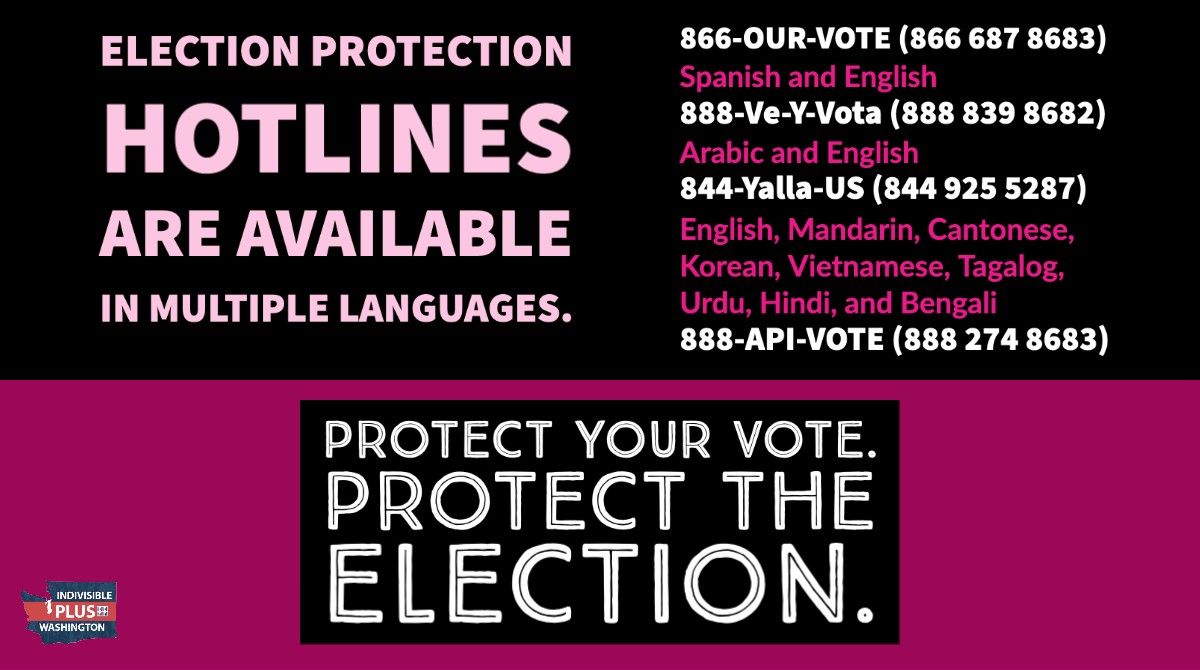
It’s also good to highlight the non-partisan Election Protection hotlines, useful for anybody experience voter intimidation or having other challenges voting. Trained volunteers are available in multiple languages:
English: 866-OUR-VOTE (866 687 8683)
Spanish/English: 888-Ve-Y-Vota (888 839 8682)
Arabic/English: 844-Yalla-US (844 925 5287)
English, Mandarin, Cantonese, Korean, Vietnamese, Tagalog, Urdu, Hindi, and Bengali: 888-API-VOTE (888 274 8683)
You can also contact Election Protection via WhatsApp, chat with them on their site 866ourvote.org or text MYVOTE to 866–687–8683.
3. REPORT disinformation when you see it
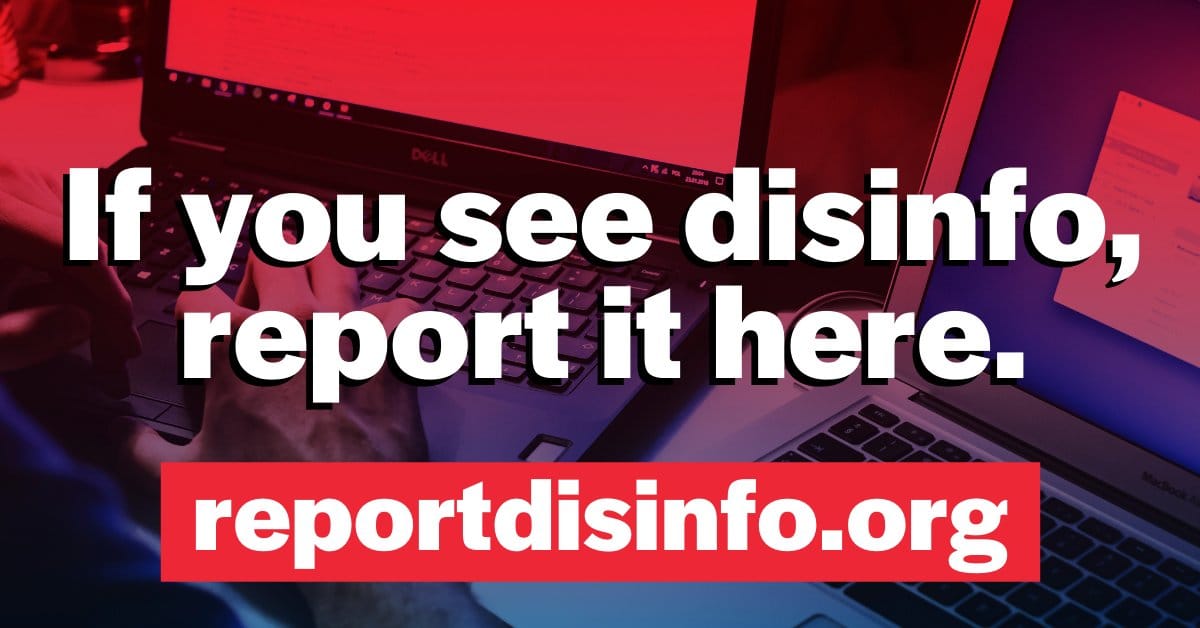
Bluesky's community guidelines specifically prohibit engaging in voter suppression, sharing misleading content about election processes, or encouraging real-world disruption of the election processes. Many Fediverse instances (aka servers), although not all, also have rules prohibiting misinformation or disinformation; even if there isn't an explicit rule, disinformation often violates other server rules, so they may well take action.
So when you see election disinformation, the first step is report it to the moderators. If this isn't something you've done before, I've got detailed instructions – with screenshots – in the appendix.
Terminology note: Misinformation is information that's false or misleading, but not necessarily intentionally. Disinformation, on the other hand, is information that's intentionally false or misleading. Kate Starbird's What’s the difference between misinformation and disinformation? has more.
And that's just the first step. Disinformation on Bluesky and the Fediverse is also likely to be on other social networks, so it's worth reporting it to ReportDisinfo.org (an easy-to-use site to report disinformation), run by Common Cause Election Fund. You can include a link – either the post or an article that it's linking to – or upload an image.
If you run into disinfo on most other social networks, it's worth reporting it there as well. The more people who report a post, the more likely it is that companies will fact-check it and potentially take it down. There's no guarantee – it's incredibly frustrating, but social network platforms will often let blatant disinformation go even after it's been reported – but it's still worth doing. X (formerly Twitter) is an exception.
4.EDUCATE yourselves — and your friends and family — about disinformation
PEN America has a lot of great resources on disinformation, including the.How to Vote and Combat Political Disinformation: A Tip Sheet for Election 2024 (which lists many of the common disinformation narratives), a primer for news consumers on spotting and combating disinformation when news breaks, the two-minute video above (originally produced for the 2020 election, but still relevant), and the hour-long video below.
PEN America's Election Countdown: Combating the Most Dangerous Disinformation Trends
And you're not the only person who needs to recognize disinformation, avoid amplifying it, and respond. Your friends, family, and colleagues do as well. So as well as educating yourself, please share the knowledge. Union of Concerned Scientists' Countering Disinformation in Your Community and PEN America's How to Talk to Friends and Family Who Share Misinformation are also excellent resources; so is this video from Sabrina Joy Stevens.
Sabrina Joy Stevens, How to Counter Disinformation: Communication Strategies, Best Practices, and Pitfalls to Avoid (from Union of Concerned Scientists)
And I know I already mentioned it, but it's worth repeating ...
SIFT (The Four Moves) is a good short introduction to the SIFT method: stop; investigate the source; find better coverage; and trace claims, quotes, and media to the original context. The five-part Check Please! Starter Course goes into much more detail. IFTAS Library’s Misinformation page has links to additional resources for investigating potential disinformation.
Even credible sources sometimes get it wrong – especially when there's fast-breaking news and rumors are flying. WNYC On The Media’s Breaking News Consumer's Handbook has some good recommendations for these fast-moving situations. Here's their infographic summary – if you want to print it out, they've got a handy PDF file.

There's a lot of great information about disinformation out there ... here's one moer, a very detailed discussion from the University of Washington Center for the Informed Public's Mini Misinfo Day
5. GET INVOLVED – and get your friends involved!
Getting out accurate voting and election protection information, or reporting disinfo when you see it, may seem mundane ... but if enough people are involved, it can make a big difference. The more people who reduce the amount of disinfo they're unentionally amplifying the better. A lot of people still don't know how to deal with disinfo, so helping educate friends and family has a huge impact as well.
If you're in the Fediverse, and you've got a bit of time, another good thing to do is to ask your instance's admins and moderators if they need help. Unlike sites like Xitter and Facebook that rely on racist, ineffective AI algorithms for moderation, the Fediverse relies on people – which is great, but is also a lot of work! So they may well appreciate the offer ...
If you want to do more, consider joining a grassroots disinfo fighting campaign. Two good non-partisan options: Common Cause's Digital Democracy Activists and Indivisible's Truth Brigade. And some candidates, or state and local party organizations, also have disinfo-fighting teams (or might interested in starting one if they don't exist yet – remember, the election doesn't end when the polls close), so check with the ones you support.
It's crunch time for democracy in the United States, so if that's something you care about, now's a good time to get involved.

Appendix: how to report disinformation
Bluesky
You can report any post by clicking on the three-dot menu and selecting "Report post".

Since Bluesky allows multiple moderation services, the first step after that is to select the official Bluesky moderation service (which should be the first and perhaps only one on your list).

Next, you need to say why you're reporting this post. "Misleading post" is the first option on the list.

This wll take you to the screen where you can once again choose different moderation services to report it to. Bluesky Moderation Service should already be checked (and it might be the only one there). There's also a text box where you can optionally give more information about the post, so you can provide an explanation (or link to one) about why it's disinfo.
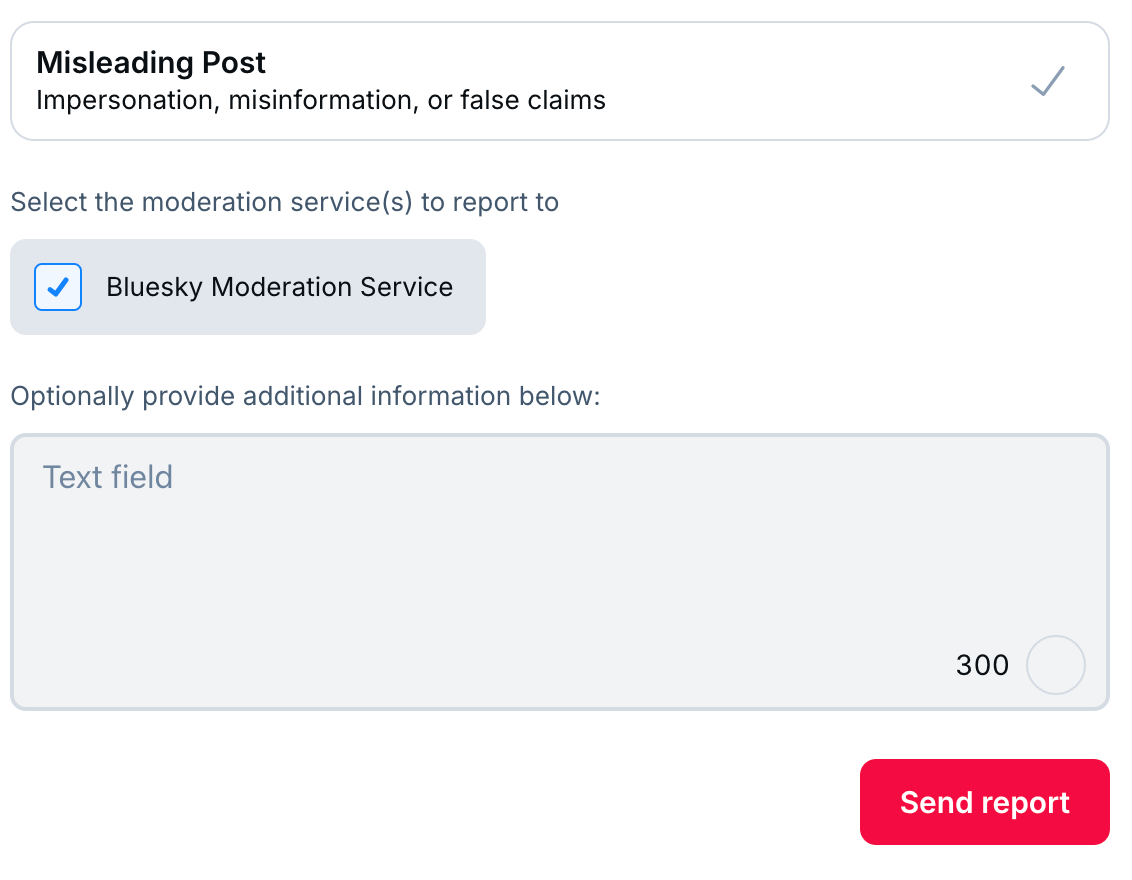
The Fediverse
Hachyderm's video on How to create a local report on Mastodon
Things are more complicated in the Fediverse. Almost all Fediverse software provides the ability to report posts, but the details are different depending on what app you're using. Most Fediverse instances have community guidelines or "server rules" prohibiting disinformation, but the wording is different on different instances. (If your instance doesn't specifically prohibit disinformation, much election disinformation is illegal content, so you can still report it, you just have to check a different box.)
Hachyderm's video above has the basics, and should work for most Mastodon instances if you're using the web UI or the official mobile apps.
Other apps may have some variations but are generally along these lines. If you (like me) prefer screenshots and text to videos, read on!
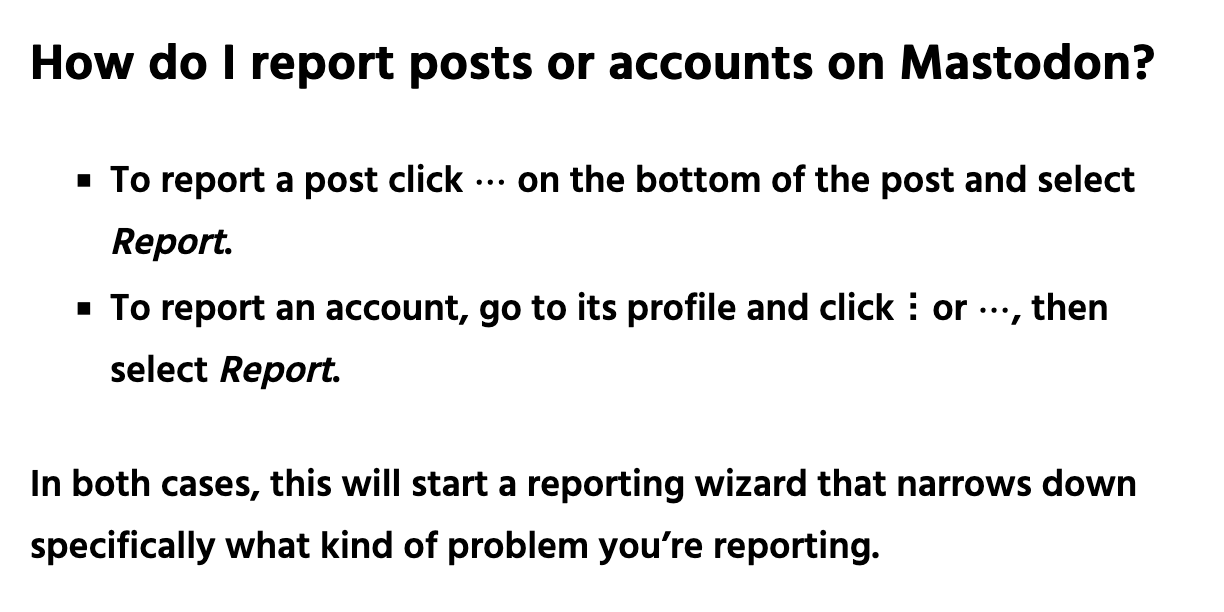
On Mastodon, you start the reporting process by clicking the three-dot "More" menu on a post (or an account profile). (If you're using a screenreader, the dots are hidden – you'll only hear the "More" label.)
Once you do that, you'll get taken to a screen that lets you specify what's wrong with the post.
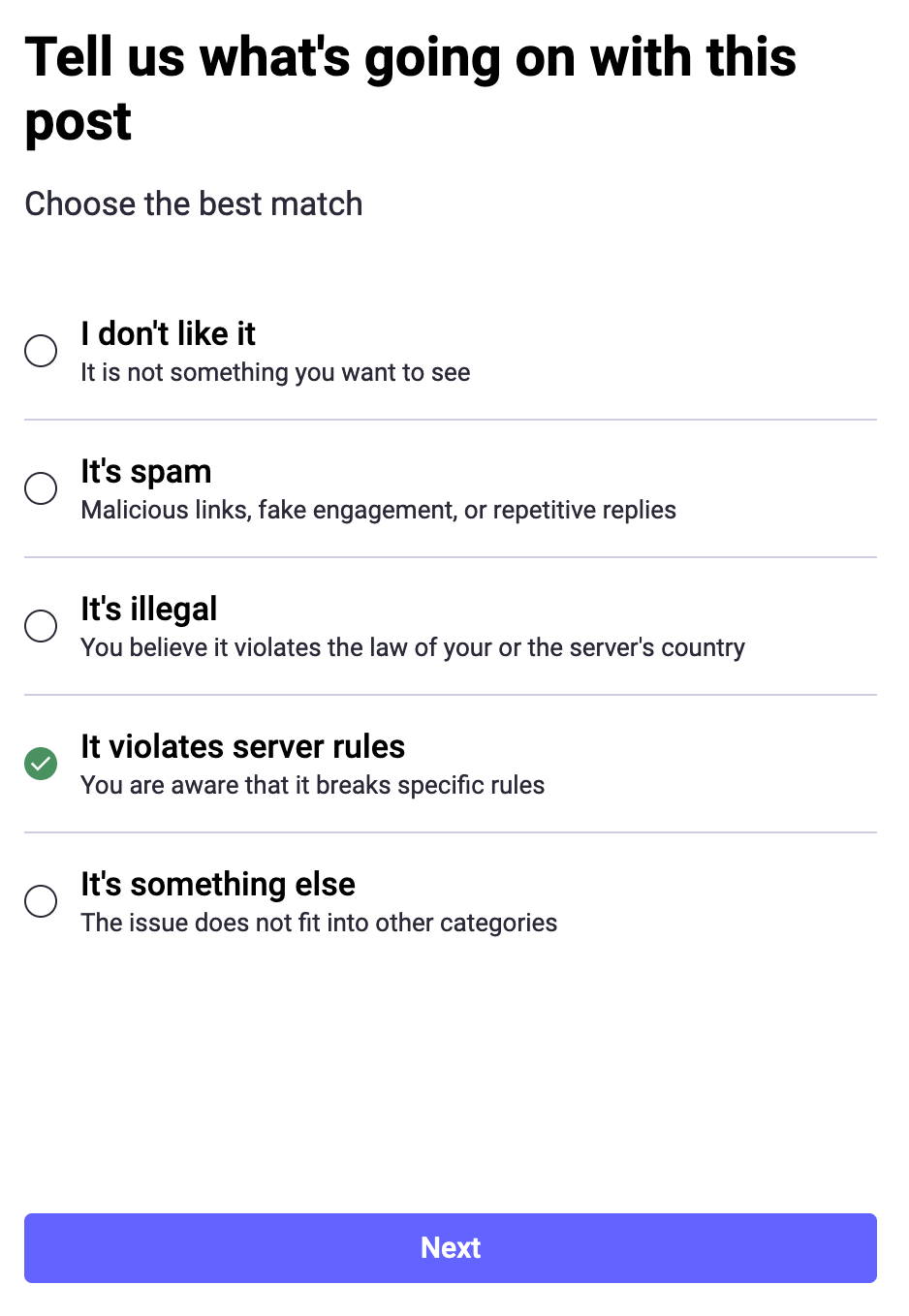
Check "It violates server rules" (or "It's illegal" if you're on an instance that doesn't prohibit disinformation), and then the Next button at the bottom of the screen. That takes you to a screen where you can specify just which rules are being violated.
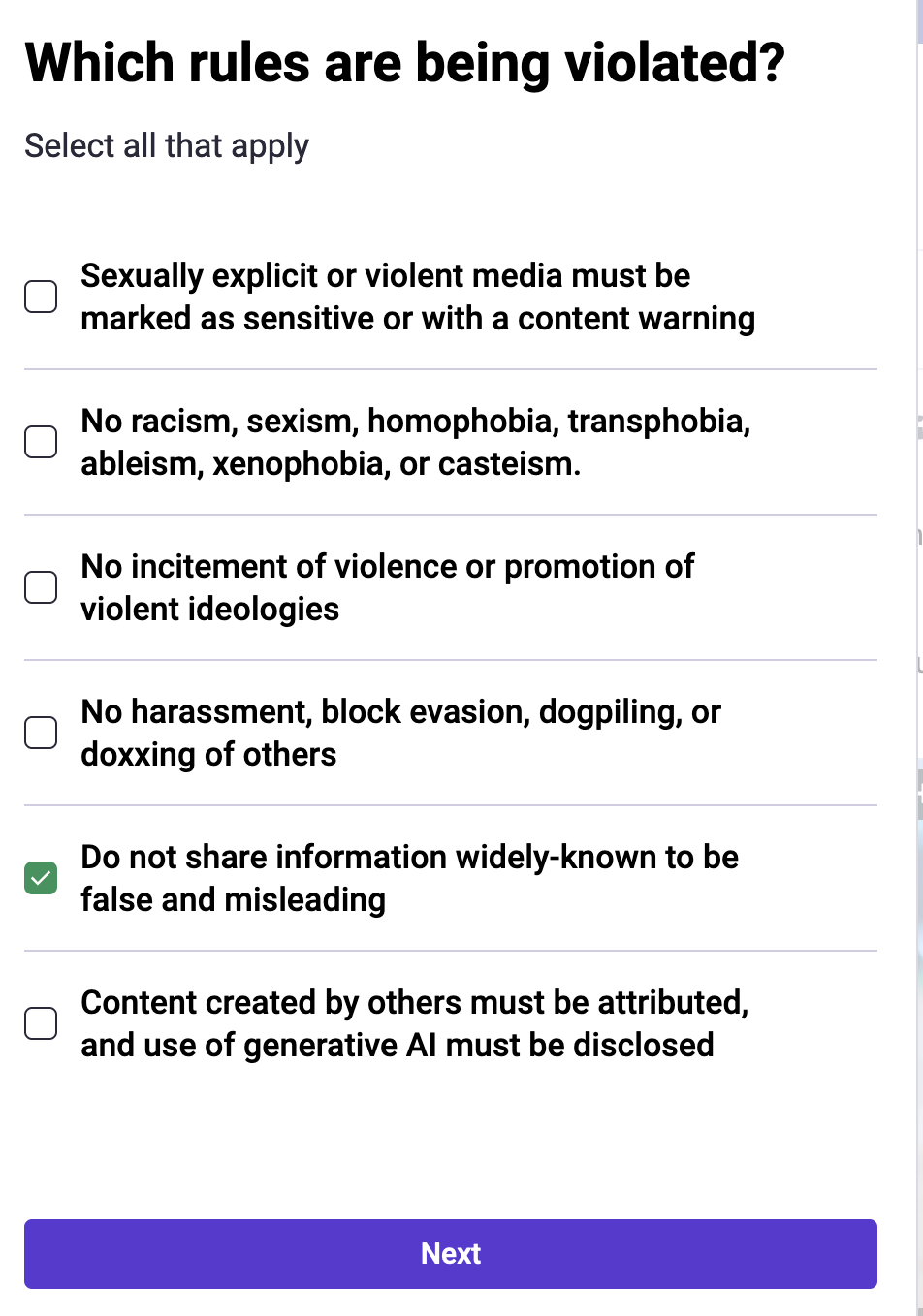
Click on the appropriate rule, and then click Next. The specifics will be different depending on what your server rules are. This screenshot is from mastodon.social, which has a rule "Do not share information widely-known to be false and misleading".
Next, you'll get a screen asking you to select posts to back up the report. The post you're reporting should be selected by default; if there are other disinfo posts from this account, this helps establish a pattern.
Click Next again and you're almost done.
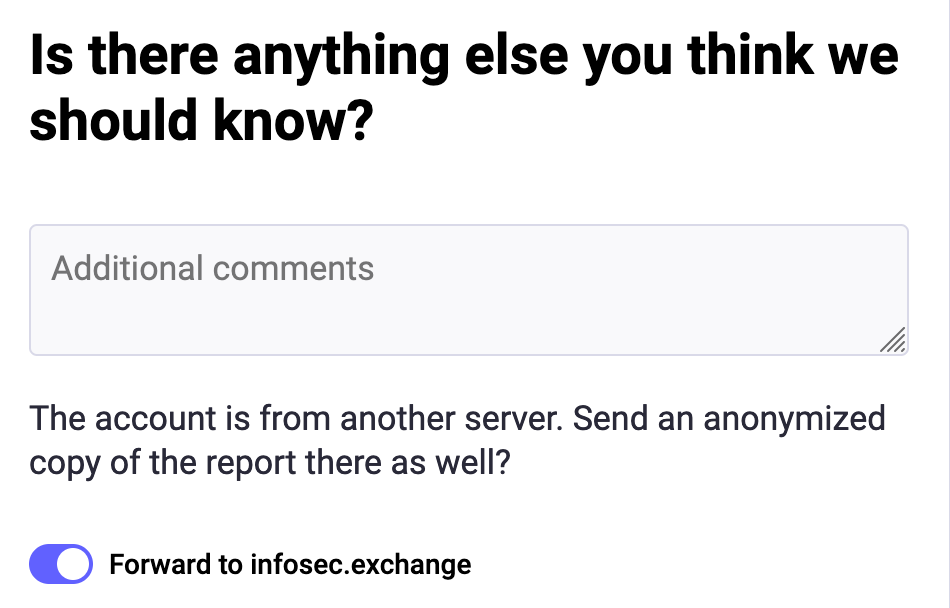
The next screen has a text box where you can provide additional information. You can help the moderators by being specific about why the post is disinfo; if you've got a link to accurate information, include that to make it easy for them to check for themselves.
If the post you're reporting is from another instance, you can also send a report to the moderators there. Usually, you want to do this (although if the other instance is something like pravda.me, where the admins and moderators are intentionally spreading disinfo, it's better not to).
Click Submit and the report will be sent to the moderators. Once you've submitted the report, you also have the option to unfollow, mute, or block the account.
Other networks
If you run into disinfo on other social networks, it's probably worth reporting it there as well. The more people who report a post, the more likely it is that companies will fact-check it and potentially take it down. There's no guarantee – it's incredibly frustrating, but social network platforms will often let blatant disinformation go even after it's been reported – but it's still worth doing.
FEEDBACK PLEASE: IS THERE A BETTER, NEWER VERSION OF THIS?

